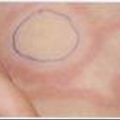8.1 CSF shunt complications
Introduction
Clinical presentation
The most common question an emergency physician will have to answer when confronted with a child who has a CSF shunt is ‘Should I refer this patient to the neurosurgical service?’ A recent study by Piatt et al1 attempted to quantify the power of various symptoms and sign to predict shunt malfunction or infection. Table 8.1.2 shows the strongly predictive signs and symptoms that allow referral to be made on the basis of that single finding. This may be done even before computerised tomography (CT) scanning, as the neurosurgeon may prefer to have the scan done locally to allow for easier comparison with previous scans (see discussion of CT scanning below). Table 8.1.3 shows the signs and symptoms with strong positive predictive power but not strong enough to warrant immediate referral if just one feature is present on its own. Thus in a patient with a ventriculoperitoneal shunt (VPS) who presents with fever alone, an initial general work up for a cause of the fever is warranted and then consideration for referral to neurosurgery made if no definite cause for the fever is found. However, fever with another feature listed in Table 8.1.3, such as headache, warrants early neurosurgical referral. The question of whether to send the child home is more difficult. The absence of any of the symptoms and signs listed in Tables 8.1.2 and 8.1.3 does not rule out shunt malfunction or infection. If concerned about shunt infection, this is much less likely if the patient is more than 6 months from the last shunt insertion or revision. However, this does not exclude shunt malfunction. Where a symptom or sign that is not of high predictive power is adequately explained by another diagnosis (e.g. vomiting with diarrhoea and recent contact with a case of gastroenteritis) CSF shunt complication is very unlikely. For cases where CSF shunt complications are neither ruled in or out on historical and examination findings, one must resort to investigations and/or observation and/or neurosurgical consultation.
| Abdominal pain |
| Fever |
| Nausea/vomiting |
| Irritability |
| Headache |
| Abnormal shunt pump test |
| Accelerated head growth |
Examination
For examination features of raised intracranial pressure see Chapter 8.2. Features of infection e.g. fever, rigors, lethargy, localised redness, swelling and peritonism (ventriculoperitoneal shunt) or pleurisy (ventriculopleural shunt) should be sought.
Shunt evaluation
Most reservoirs can be compressed easily and rapidly refill in a few seconds. Incompressibility of the bulb is usually due to obstruction of the distal catheter. This is the less common site of obstruction. If the bulb compresses easily but does not refill, then the proximal catheter is blocked. This is the ‘shunt pump test’. An abnormality of the test did not perform well enough to warrant immediate referral in Piatt’s study.1 This is because it can be difficult to tell if a test is abnormal or not. The return of the chamber after depression can take a number of minutes and may take longer if the choroid plexus is drawn into the catheter causing partial or complete obstruction. This is the reason why shunt pump tests should be kept to a minimum as multiple tests can not only cause blockage with choroid but also other debris and the ventricular wall, and can cause low pressure headache.
Investigations
On rare occasions, insertion of a needle into a shunt pumping chamber may be useful for both diagnostic and therapeutic reasons but should generally be performed by neurosurgical colleagues. The exception is in the rapidly deteriorating child, where contact with the neurosurgeon is delayed or where in remote locations after discussion with the treating neurosurgeon it is considered important to get some information to help with a decision to transport. In the case of a moribund child, an emergency physician may relieve the raised intracranial pressure by inserting a 25-gauge butterfly needle into the bulb/pumping chamber at 45 degrees to the skin under strict aseptic technique.2 It is important not to advance too deeply as the needle can damage valve mechanisms so badly that replacement is necessary. The pressure can be measured with a similar technique to that used in a lumbar puncture and then CSF drained off until the pressure is 10 cmH2O.
Aspects of some CSF shunt complications
Infection
The diagnosis of shunt infection is not always straightforward. In a retrospective case series.3 the presenting symptoms were as listed in Table 8.1.4.
1 Piatt J.H., Garton H.J. Clinical diagnosis of ventriculoperitoneal shunt failure among children with hydrocephalus. Pediatr Emerg Care. 2008;24(4):201-210.
2 Roberts J.R. Clinical Procedures in Emergency Medicine, 5th ed. Philadelphia, PA: WB Saunders Company; 2009.
3 Williams D.G., Hayes J., McCool S. Shunt infection in children: presentation and management. J Neurosci Nurs. 1996;28(3):155-162.




